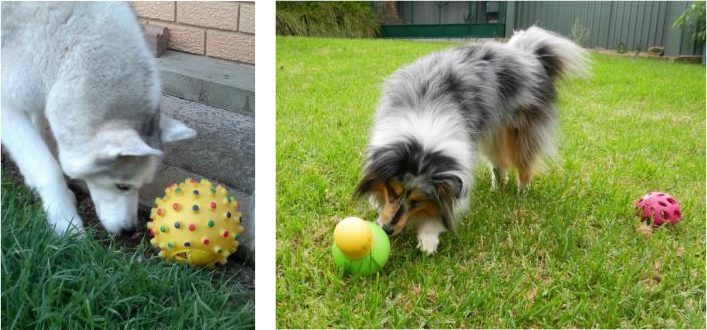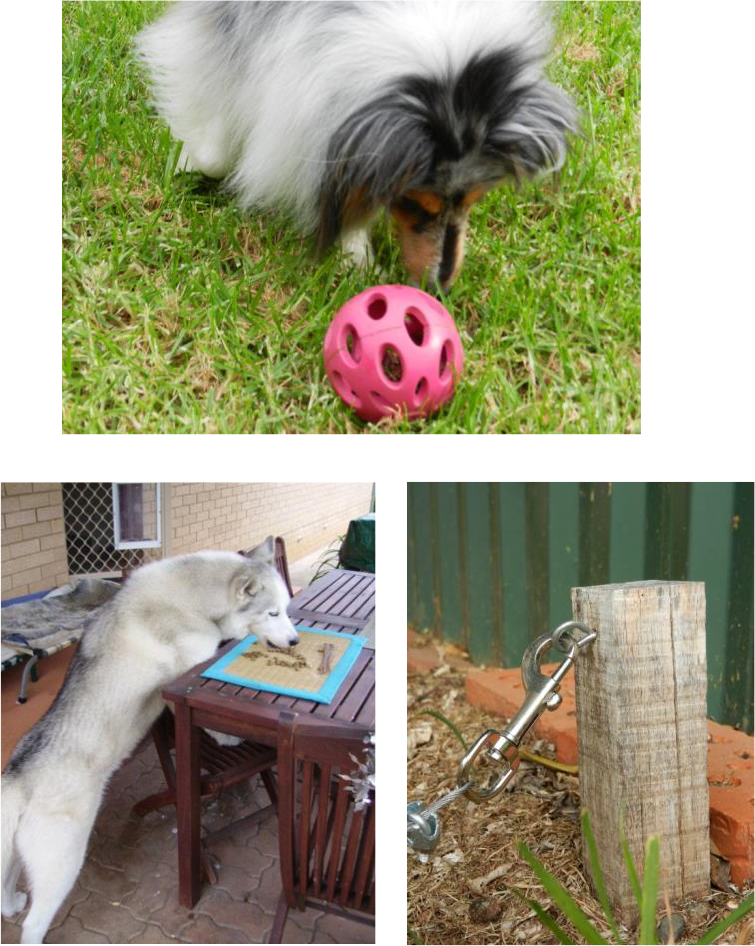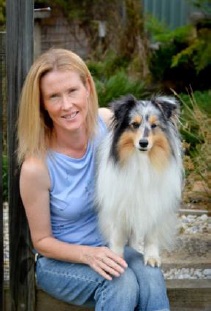The Art of Introducing Dogs (13 page)
Read The Art of Introducing Dogs Online
Authors: Louise Ginman

Kongs
— Buy one or two and stuff with treats, kibble, cheese etc. Get black Kongs for destructive chewers. Make it hard by topping off with crisscrossed biscuits, peanut butter or low fat cream cheese.
Raw egg
— can hide it in boxes or simply hide somewhere in the yard
Chicken wings/ drumsticks and necks
— I use the wings and drums to signal to my dogs that I am going out — I generally hand feed these or place them in a cardboard box. Hide the chicken necks around the yard. Chicken must be fed raw.
Note
Only feed these items to dogs that will chew them, do not give unsupervised to any dog that will swallow without chewing.
Plastic bottles
— use the PET type as they are tough and not brittle. Put biscuits, kibble and treats inside the bottles and hide these around the yard.
Tetra paks
— these are also great to put treats/kibble inside. They are fairly tough and so your dog has to work fairly hard to get food out.
Huge variety of toys
— squeaky toys, plush toys, balls from tennis ball size up to soccer ball size, rope toys. There is a huge variety out there. I rotate my dog’s toys 2–3 times per week and give him 7 toys at a time. I now have enough toys that he only has the same toy once per month.
Dried meat treats
kangaroo jerky, pigs ears, trotters, etc., —
again there is a huge variety of chew treats available from pet stores. They can provide hours of chewing and can also be hidden in boxes or around the yard.
Ice blocks —
In Summer, you can keep your dog busy with an ice block — you can make ice blocks out of diluted ‘pet’ milk, sandwich tuna, meat stock etc. Freeze in ice cream containers, the bigger they are the longer they last.
Daily exercise —
long walks, games, hiking, dog parks, training etc.
Yes, getting out and about with your dog is essential and should form a big part of any enrichment program and indeed part of every dog’s daily life. For destructive dogs, a 30–45 minute walk before you go to work is great as it releases a lot of the energy that your dog would normally use to be destructive once you leave. If you can’t squeeze a walk into an already busy morning then you must make time to walk after work. Most dogs do well with a minimum 30–60 minute walk every day. Vary where you walk to keep it interesting for both of you e.g., I have 10 different walks that I do in my neighborhood plus I visit the dog park three times a week for 60–90 minutes. You can also get involved in activities like fly ball, agility, herding, tracking or lure coursing as well as other activities that your breed is designed for.
The important thing is to make sure you do not give the same things every day. The greater the variety the more you can mix them up, rotate them and be inventive. Try to make things hard for your dogs as they get better at finding things around the yard or accessing the treats etc. All animals habituate to things, which mean that the more your dog’s get something, the less likely they are to react to it. Keep them constantly guessing at what you have given them today. Try creating a fortnightly enrichment schedule that you can follow. Put it up on the fridge at home so everyone in the home can follow it. The following page has a very basic sample schedule. Even your dogs’ meals and exercise/training program can be part of the schedule to ensure they have lots of variety.
The benefits of providing enrichment to your dogs from day 1, is that they learn that these items are OK to chew, rip up etc. Your dogs have an outlet for chewing, mouthing and playing. I have found that my dogs are not destructive at all in my home or yard. Plus, by giving the enrichment items to your dog’s when you go to work or go out, it helps the dogs to focus on something other than the fact that you have gone and because these things are fun, your dogs will actually enjoy you leaving just so they get something special.
There are a huge variety of treat dispensing balls/toys available. Aim to have a minimum of 6–8 per dog.


(Left) Placing treats up high for the larger dog can prevent smaller dogs from accessing treats. (right) Tethering enrichment items can prevent one dog from collecting and guarding items. Tethers should be placed at least 3 metres’ apart
| Monday | Enrichment item (3–6 daily) | |
| | ||
| On the menu Drumstick (am) Chicken neck (pm) | Treat ball 1 and 2 Kong Box and plastic bottle | Dog Park 60 -90 mins Obedience training |
| Tuesday | ||
| | ||
| On the menu Lamb (am) Bone (pm) | Treat ball 3 and 4 Pinecone Box and plastic bottle | Walk — 60 mins |
| Wednesday | ||
| | ||
| On the menu Beef (pm) Wing (am) | Treat ball 5, 6 and 7 Tetra pak Plastic bottle | Dog Park 60 -90 mins Agility training |
| Thursday | ||
| | ||
| On the menu Turkey (am) Bone (pm) | Treat ball 1 and 4 Pinecone Box and plastic bottle | Walk — 60 mins Ball game |
| Friday | ||
| | ||
| On the menu Drumstick (am) Sardines (pm) | Treat ball 2, 5 and 8 Tetra pak Box | Dog Park 60 -90 mins |
| Saturday | ||
| | ||
| On the menu Turkey (am) Kangaroo (pm) | Treat ball 3 and 6 Kong Box and plastic bottle | Walk — 2 × 30 mins Recall game |
| Sunday | ||
| | ||
| On the menu Wing (am) Bone (pm) | Treat ball 1 2 and 3 Pinecone Box and plastic bottle | Walk — 60 mins Find it game |

About the Author
Louise Ginman is a qualified Dog Behavioural Trainer who runs a dog training business ‘Positive Dogs’ in Sydney, Australia. She has been an Education committee member of APDT Australia Inc. since 2008 and President since 2012. Louise has several qualifications including a Bachelor of Science Degree and Certificate IV in Companion Animal Services. Louise has over 20 years’ experience with both domestic and exotic species in both a training and husbandry/management capacity. Louise worked as a veterinary nurse, dog and cat groomer and animal attendant in a busy and large practice in the Eastern Suburbs of Sydney for several years before moving to Taronga Zoo to work in the Animal Presentation Unit. She then moved permanently to the Carnivore Unit where she is the Unit Supervisor.
Louise’s experience in introductions of animals spans 18 years. She has implemented introduction plans and successfully introduced species as diverse as Lions, Tigers, Snow Leopards, Kodiak bears, Sun bears Meerkats, Fennec Fox, Asian Wild Dog, Red Pandas, Otters, Binturong, Malayan Tapir, Fishing Cats and Golden Cats.
Dogs have always been Louise’s passion and she continues today to educate people about living in harmony with their dog through her writing and pet dog training courses.
Inside back cover
The Art of Introducing Dogs—A guide for conducting dog to dog introductions
.
People add a new dog or puppy to their household often without any planning taking place or consideration of how that new dog or puppy will affect the dynamics of the current family and resident dog/s. ‘The Art of Introducing Dogs’ looks at a whole range of important considerations before you add a new dog or puppy such as:
- the sex or age the newcomer should be
- Determining play styles of the dogs
- Looking at socialisation histories
- Established preferences of your dog
The book also looks at how you can assess the new dog or puppy before getting your heart set on it as well carrying out introductions whether on or off lead, using neutral territories, crossover of scent, parallel walking, dog passing dog and curving techniques. There is also detailed information on moving from the introduction to living together at home.
An indispensable resource for anyone wanting to perform dog to dog introductions
.
“For anyone considering getting another dog, the ‘Introducing Dogs’ is a must have purchase. The book is extremely thorough covering all aspects of second dog ownership from assessing different play styles and levels of socialization to step by step practical introductions expressed in a simple, easy to read style”
Karin Bridge Cert IV CGC instructor Get Smart Dog Training
“Louise Ginman has created an invaluable resource for dog-lovers looking to add another member to their canine family. Proper selection and introduction of new family members can go a long way toward ultimate peace in the pack. Be sure you read this book before you adopt, to maximize your new-dog success.”
Pat Miller CBCC-KA, CPDT-KA, CDBC, Peaceable Paws
